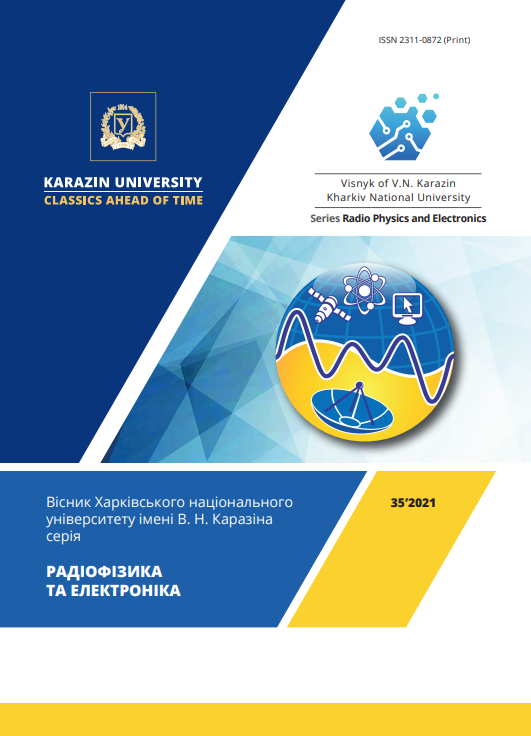Optic properties of ZnO films grown by sol-gel technique
Abstract
Background. Zinc oxide (ZnO) is a promising material for designing the semiconductor radiation sources and detectors in the region of short wavelengths of the optical range. Films based on ZnO are considered as possible elements of optoelectronic devices that can be used to influence their optical properties. Nowadays, the methods of making such films are quite diverse, however, obtaining high-quality and inexpensive ZnO films remains an actual scientific and engineering task that needs to be solved. Thus, the research in this direction and the development of recommendations on the synthesis of ZnO films is urgent.
Purpose of Work. The aim of the work is to obtain ZnO films by the sol-gel technique, to evaluate their structure and optical properties and to estimate the affect of ultraviolet radiation on the structure and optical characteristics of the obtained films.
Techniques and Methodology. The process of obtaining ZnO films is considered. The process of obtaining such films by sol-gel technique is described. A visual analysis of the experimentally obtained films has been carried out. The optical properties of ZnO films were experimentally examined. In particular, the influence of ultraviolet radiation used at the stage of obtaining films on the features of their ability to absorb radiation in the optical range is analyzed.
Results. ZnO films were grown experimentally by sol-gel technique. ZnO films were formed on quartz substrates. The formation of ZnO nanoparticles is observed in the films obtained without the influence of radiation. The usage of ultraviolet radiation at the stage of the final heat treatment at a temperature of 480 °C leads to the formation of a higher quality ZnO film and a decrease in the size of the granules. Analysis of the chemical composition of the films using X-ray fluorescence analysis shows the presence of zinc and oxygen in the formed films, as well as insignificant carbon content, which is associated with the use of quartz as substrates. The dependencies of the transmission capacity of ZnO films on the wavelength of radiation incident on the film in the range of 200-450 nm are obtained. It is shown that in films exposed to ultraviolet radiation at the stage of heat treatment, there is a shift in the value of the cut-off wavelength corresponding to the absorption edge and, accordingly, a decrease in the band gap calculated from the results of the experiment.
Conclusions: To summarize the results of the research we can highlight that the influence of ultraviolet radiation at the stage of the final heat treatment on ZnO films formed by sol-gel method leads to an improvement in the quality of the films and to a change in their optical properties, in particular, a decrease in the energy corresponding to the absorption threshold.
Downloads
References
2. Park JW, Kang BH, Kim HJ. A Review of Low‐Temperature Solution‐Processed Metal Oxide Thin‐Film Transistors for Flexible Electronics. Advanced Functional Materials. 2019 Sep 6;30(20):1904632. https://doi.org/10.1002/adfm.201904632
3. T-Thienprasert J, Rujirawat S, Klysubun W, Duenow JN, Coutts TJ, Zhang SB, et al. Compensation in Al-Doped ZnO by Al-Related Acceptor Complexes: Synchrotron X-Ray Absorption Spectroscopy and Theory. Physical Review Letters. 2013 Jan 28;110(5).055 502. https://doi.org/10.1103/PhysRevLett.110.055502
4. Siddiqua P, Hadi WA, Shur MS, O’Leary SK. A 2015 perspective on the nature of the steady-state and transient electron transport within the wurtzite phases of gallium nitride, aluminum nitride, indium nitride, and zinc oxide: a critical and retrospective review. Journal of Materials Science: Materials in Electronics. 2015 May 23;26(7):4475–512. http://dx.doi.org/10.1007/s10854-015-3055-7
5. Adachi S. Properties of Semiconductor Alloys: Group-IV, III–V and II–VI Semiconductors. Chichester: Wiley; 2009. 424 p.
6. Siddiqi KS, ur Rahman A, Tajuddin, Husen A. Properties of Zinc Oxide Nanoparticles and Their Activity Against Microbes. Nanoscale Research Letters [Internet]. 2018 May 8;13(1). https://doi.org/10.1186/s11671-018-2532-3
7. Crossay A, Buecheler S, Kranz L, Perrenoud J, Fella CM, Romanyuk YE, et al. Spray-deposited Al-doped ZnO transparent contacts for CdTe solar cells. Solar Energy Materials and Solar Cells. 2012 Jun;101:283–8. https://doi.org/10.1016/j.solmat.2012.02.008
8. Sharma S, Vyas S, Periasamy C, Chakrabarti P. Structural and optical characterization of ZnO thin films for optoelectronic device applications by RF sputtering technique. Superlattices and Microstructures. 2014 Nov;75:378–89. http://dx.doi.org/10.1016/j.spmi.2014.07.032
9. Franklin JB, Zou B, Petrov P, McComb DW, Ryan MP, McLachlan MA. Optimised pulsed laser deposition of ZnO thin films on transparent conducting substrates. Journal of Materials Chemistry. 2011;21(22):8178-8182. https://doi.org/10.1039/C1JM10658A
10. Szyszka B, Sittinger V, Jiang X, Hong RJ, Werner W, Pflug A, et al. Transparent and conductive ZnO:Al films deposited by large area reactive magnetron sputtering. Thin Solid Films. 2003 Oct;442(1-2):179–183. https://doi.org/10.1016/s0040-6090(03)00968-4
11. Liu H, Liu Y-F, Xiong P-P, Chen P, Li H-Y, Hou J-W, et al. Aluminum-Doped Zinc Oxide Transparent Electrode Prepared by Atomic Layer Deposition for Organic Light Emitting Devices. IEEE Transactions on Nanotechnology. 2017 Jul;16(4):634-638. https://doi.org/10.1109/TNANO.2017.2700408
12. Opel M, Geprägs S, Althammer M, Brenninger T, Gross R. Laser molecular beam epitaxy of ZnO thin films and heterostructures. Journal of Physics D: Applied Physics. 2013 Dec 23;47(3):034002. http://dx.doi.org/10.1088/0022-3727/47/3/034002
13. Barankin MD, Gonzalez II E, Ladwig AM, Hicks RF. Plasma-enhanced chemical vapor deposition of zinc oxide at atmospheric pressure and low temperature. Solar Energy Materials and Solar Cells. 2007 Jun;91(10):924–930. http://dx.doi.org/10.1016/j.solmat.2007.02.009
14. Rashid ARA, Hazwani TN, Mukhtar WM, Taib NAM. Influence of annealing temperature on optical properties of Al doped ZnO nanoparticles via sol-gel methods. AIP Conference Proceedings. 2018;1972:030006. https://doi.org/10.1063/1.5041227
15. AL-ANI SKJ. Determination of the optical gap of amorphous materials. International Journal of Electronics. 1993 Dec;75(6):1153-1163. https://doi.org/10.1080/00207219308907191
16. Ray AK, Hogarth CA. On the analysis of experimental data for optical absorption in non-crystalline materials. Journal of Physics D: Applied Physics. 1990 Apr 14;23(4):458-459. https://doi.org/10.1088/0022-3727/23/4/012
17. Marouf S, Beniaiche A, Guessas H, Azizi A. Morphological, Structural and Optical Properties of ZnO Thin Films Deposited by Dip Coating Method. Materials Research. 2016 Nov 28;20(1):88–95. https://doi.org/10.1590/1980-5373-MR-2015-0751
18. Mott NF, Davis EA. Electronic processes in non-crystalline materials. Calendron Press; New York: Oxford University Press; 1979. 608 p.




